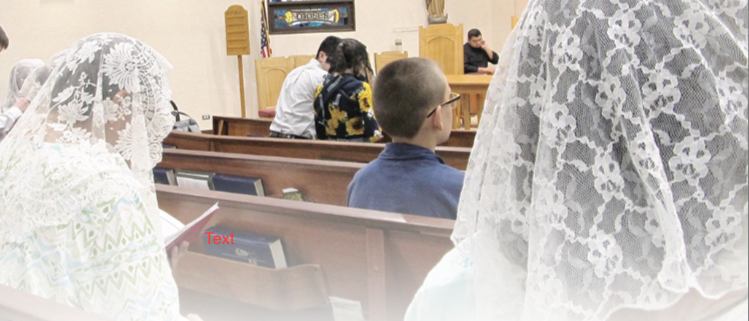Written by Carol Baass Sowa, for Today’s Catholic
A Mass from the growing more distant past is very much part of the present in San Antonio. Half a century has gone by since the Second Vatican Council and introduction of the “new order” Mass, with all its changes, but the Traditional Latin Mass or TLM (also known as the Tridentine or extraordinary form) continues to fill a need for the faithful, here and elsewhere.
For the Archdiocese of San Antonio, the official archdiocesan Mass in this form is celebrated weekly at St. Pius X Church at 3907 Harry Wurzbach Road at 1:30 p.m. Sundays and 8 a.m. Saturdays. It serves a community of around 200 that draws attendance from area towns, including Fredericksburg, Boerne, New Braunfels, Seguin, and Converse.
In 2007, Pope Benedict XVI issued the motu proprio letter Summorum Pontificu, authorizing use of the Latin Mass as last published in the 1962
Missal. This is a different Latin Mass than Pope Paul VI’s novus ordo (new order) Mass, whose official text is Latin but is more commonly celebrated in the vernacular, or language spoken by the people of a county or region. It is considered the ordinary form and the TLM Mass, the extraordinary form.
Robert and Lona Sanchez, retired teachers and devoted members of this special community, returned to their former parish of St. Pius X after raising their family in Georgia and were excited when learning the Latin Mass would be established here in 2008. “It was like coming home,” says Lona, who grew up with the Tridentine Mass and recalls the nuns teaching her that the Mass is the sacrifice of Christ and that the priest, looking up at the cross with his back to the congregation, represented Christ offering the sacrifice for us again.
The music is traditional and, for high Masses, there is choral singing in uplifting Gregorian chant. The only musical instrument is the organ. Text in the vernacular is found in the missal and the homily is spoken in the vernacular.
The Sanchezes have noticed the Latin Mass is drawing young adults with large families. “It’s not like you’re going into a nursing home,” adds Robert, countering the perception that this is merely a Mass for old folks nostalgic for the past.
Priests able to say the Latin Mass are growing scarcer though and it is only due to the generosity of those who know it (or are willing to learn) volunteering that the Traditional Latin Mass has been available at St. Pius X. The latter is the case with new priestly shepherd for the local TLM community, Father Juan Carlos Tejada, a native of El Salvador and pastor at St. Timothy Parish.
Entering the seminary, he took Latin for three and a half years and did well in it. “I’m never going to use it,” he said to himself, but God had plans.
When Father James Fischler, CICM, archdiocesan director of clergy, put out a call last year for priests willing to celebrate the Latin Mass, Father Tejada felt his heart afire. “Probably God has formed me for this,” he thought. Still, he waited a few days to gather courage before approaching Father Fischler. “I think I know Latin and I pray my rosary in Latin,” he told him. “I never celebrated the Latin Mass before, but I’m willing to learn.” A priest had already been found for the position, but Father Tejada still wanted to learn the Mass and, with approval of Archbishop Gustavo García-Siller, MSpS, began taking instructions from Father Franz Schorp, SM, a mainstay here for the Latin Mass community.
Now, Father Tejada has been the TLM priest since May and notes it has helped him celebrate the regular Mass with more reverence. “It helps me to love my priesthood every time I celebrate Mass,” he says, explaining it is the Mass of many great saints – St. Padre Pio, St. Ignatius of Loyola, Pope Saint John XXIII and his favorite, St. Oscar Romero, whose picture he carries, showing the martyred priest celebrating the Latin Mass on a rustic altar in the mountains of El Salvador. “I’m celebrating that Mass of his first Masses,” Father Tejada says thoughtfully.
For those who remember the Tridentine Mass, attending will feel like stepping back in time to pre-Vatican II. For younger generations, this may take some getting used to. An altar rail with kneelers had to be re-installed at St. Pius, for the Eucharist in TML is received only on the tongue while kneeling.
Also, harking back to pre-Vatican Council II days, Communion is only distributed in one species (no wine) and only by a priest or deacon, accompanied by male altar servers bearing patens. There are no lay ministers or “altar girls.” Mantillas (lace veils), worn as a sign of respect as in years gone by, are the predominant head apparel for women, though not required, and you will see uncovered heads and an occasional hat. Men, of course, doff their hats.
Father Tejada and the Sanchezes are grateful Pope Benedict XVI brought the Tridentine Mass out of its seemingly “hidden” state. Though celebrating it with permission was always permitted, few did so. Now, there are two forms of the Roman Rite available.


